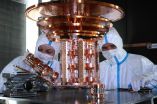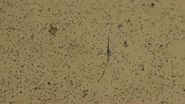(Press-News.org) As we grow older, we lose strength and muscle mass. However, the cause of age-related muscle weakness and atrophy has remained a mystery.
Scientists at the University of Iowa have discovered the first example of a protein that causes muscle weakness and loss during aging. The protein, ATF4, is a transcription factor that alters gene expression in skeletal muscle, causing reduction of muscle protein synthesis, strength, and mass. The UI study also identifies two natural compounds, one found in apples and one found in green tomatoes, which reduce ATF4 activity in aged skeletal muscle. The findings, which were published online Sept. 3 in the Journal of Biological Chemistry, could lead to new therapies for age-related muscle weakness and atrophy.
"Many of us know from our own experiences that muscle weakness and atrophy are big problems as we become older," says Christopher Adams, MD, PhD, UI professor of internal medicine and senior study author. "These problems have a major impact on our quality of life and health."
Previously, Adams and his team had identified ursolic acid, which is found in apple peel, and tomatidine, which comes from green tomatoes, as small molecules that can prevent acute muscle wasting caused by starvation and inactivity. Those studies set the stage for testing whether ursolic acid and tomatidine might be effective in blocking the largest cause of muscle weakness and atrophy: aging.
In their latest study, Adams' team found that ursolic acid and tomatidine dramatically reduce age-related muscle weakness and atrophy in mice. Elderly mice with age-related muscle weakness and atrophy were fed diets lacking or containing either 0.27 percent ursolic acid, or 0.05 percent tomatidine for two months. The scientists found that both compounds increased muscle mass by 10 percent, and more importantly, increased muscle quality, or strength, by 30 percent. The sizes of these effects suggest that the compounds largely restored muscle mass and strength to young adult levels.
"Based on these results, ursolic acid and tomatidine appear to have a lot of potential as tools for dealing with muscle weakness and atrophy during aging," Adams says. "We also thought we might be able to use ursolic acid and tomatidine as tools to find a root cause of muscle weakness and atrophy during aging."
Adams' team investigated the molecular effects of ursolic acid and tomatidine in aged skeletal muscle. They found that both compounds turn off a group of genes that are turned on by the transcription factor ATF4. This led them to engineer and study a new strain of mice that lack ATF4 in skeletal muscle. Like old muscles that were treated with ursolic acid and tomatidine, old muscles lacking ATF4 were resistant to the effects of aging.
"By reducing ATF4 activity, ursolic acid and tomatidine allow skeletal muscle to recover from effects of aging," says Adams, who also is a member of the Fraternal Order of Eagles Diabetes Research Center at the UI and a staff physician with the Iowa City Veterans Affairs Medical Center.
The UI study was done in collaboration with Emmyon, Inc., a UI-based biotechnology company founded by Adams, that is now working to translate ursolic acid and tomatidine into foods, supplements, and pharmaceuticals that can help preserve or recover strength and muscle mass as people grow older.
INFORMATION:
In addition to Adams, the UI team included Michael Dyle, Steven Bullard, Jason Dierdorff, Daryl Murry, Daniel Fox, Kale Bongers, Vitor Lira, and David Meyerholz, as well as Scott Ebert and John Talley at Emmyon, Inc.
The study was funded by a Small Business Innovation Research (SBIR) grant to Emmyon, Inc. from the National Institute on Aging, as well as grants from the Department of Veterans Affairs and the Fraternal Order of Eagles Diabetes Research Center at the University of Iowa.
PITTSBURGH--There are plenty of ways in the lab to determine which bug is bugging you when you're sick. The University of Pittsburgh's Xinyu Liu, Sanford Asher, and colleagues may have found a faster method.
"You can do a swab and culture the bacterium or fungi, but that takes days," Liu says. "You can examine the DNA, but that takes another day or two. It's a pretty tedious process. So, before the identity of the pathogen can be determined, doctors give infected people a broad-spectrum antibiotic that kills everything."
It would be better for the patient, then, to ...
Researchers have proven that rudeness -- like poison in the water cooler -- is toxic in the workplace, affecting both job and business performance. But what if your office is a hospital Intensive Care Unit where lives hang in the balance?
A new Tel Aviv University study published in Pediatrics suggests that even the most benign forms of impoliteness may impede medical personnel's ability to perform under pressure and damage the quality of patient care. Rudeness alone accounts for a significant drop in hospital staff's diagnostic and professional performance, according ...
CAMBRIDGE, Mass.--The boiling of water is at the heart of many industrial processes, from the operation of electric power plants to chemical processing and desalination. But the details of what happens on a hot surface as water boils have been poorly understood, so unexpected hotspots can sometimes melt expensive equipment and disable plants.
Now researchers at MIT have developed an understanding of what causes this extreme heating -- which occurs when a value known as the critical heat flux (CHF) is exceeded -- and how to prevent it. The new insights could make it possible ...
This news release is available in German.
The Earth, planets, stars, and galaxies form only the visible portion of the matter in the universe. Greater by far is the share accounted for by invisible "dark matter". Scientists have searched for the particles of dark matter in numerous experiments - so far, in vain.
With the CRESST experiment, now the search radius can be considerably expanded: The CRESST detectors are being overhauled and are then able to detect particles whose mass lies below the current measurement range. As a consequence, the chance of tracking ...
Washington, DC (September 8, 2015) - The modern-day complaints department tends to be a direct mention on Twitter to the company that has wronged you. It's easier than ever to have a direct line to a company, but what does a corporation get out of this interaction? A recent study published in the Journal of Computer-Mediated Communication by researchers at VU University Amsterdam, The Netherlands, found that people who follow corporate social media accounts that present a human voice are more likely to have a positive view of the company.
Corné Dijkmans (NHTV Breda ...
Sticky resin from conifers contains substances that could relieve or cure epilepsy. Researchers at Linköping University have synthesized and tested 71 substances known as resin acids, of which twelve are prime candidates for new medicines.
"Our goal is to develop some of the most potent substances into medicines," says Fredrik Elinder, professor of molecular neurobiology and head of the study, which was newly published in Nature's open-access periodical Scientific Reports.
Professor Elinder is an expert on the function of ion channels - the pores in the cell membrane ...
Individual transistors made from carbon nanotubes are faster and more energy efficient than those made from other materials. Going from a single transistor to an integrated circuit full of transistors, however, is a giant leap.
"A single microprocessor has a billion transistors in it," said Northwestern Engineering's Mark Hersam. "All billion of them work. And not only do they work, but they work reliably for years or even decades."
When trying to make the leap from an individual, nanotube-based transistor to wafer-scale integrated circuits, many research teams, including ...
Typhoon Kilo continues to thrive in the Northwestern Pacific and imagery from NASA's Terra satellite late on September 7 showed that the storm still maintained a clear eye.
The MODIS or Moderate Resolution Imaging Spectroradiometer instrument that flies aboard Terra provided a visible-light image of Kilo on September 7 at 23:50 UTC (7:50 p.m. EDT). The image showed thick bands of thunderstorms wrapping around the eastern and northern quadrants of the visible eye.
At 0900 UTC (5 a.m. EDT) on September 9, Typhoon Kilo had maximum sustained winds near 65 knots (74.8 mph/120.4 ...
This news release is available in French.
Montreal, September 8, 2015 -- All countries have contributed to recent climate change, but some much more so than others. Those that have contributed more than their fair share have accumulated a climate debt, owed to countries that have contributed less to historical warming.
This is the implication of a new study published in Nature Climate Change, in which Concordia University researcher Damon Matthews shows how national carbon and climate debts could be used to decide who should pay for the global costs of climate ...
Scientists at Texas A&M University have made additional progress in understanding the process behind scar-tissue formation and wound healing -- specifically, a breakthrough in fibroblast-to-fibrocyte signaling involving two key proteins that work together to promote fibrocyte differentiation to lethal excess -- that could lead to new advances in treating and preventing fibrotic disease.
A new study led by biologists Richard Gomer and Darrell Pilling and involving Texas A&M graduate students Nehemiah Cox and Rice University technician Varsha Vakil points to a naturally ...



